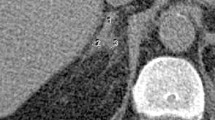Abstract
Acute adrenal ischemia represents a rare cause of adrenal insufficiency which should be promptly diagnosed in order to preserve adrenal vitality and function. Our study aims to retrospectively evaluate the diagnostic accuracy of the CT capsular sign as an indicator of adrenal ischemia and its association with vascular involvement. Between January 2013 and January 2014, 69 consecutive patients (47 men, 22 women; mean age 46; range 22–67) with suspected adrenal insufficiency based on clinical and biochemical data underwent 320-row CT examination in our Emergency Department. Written informed consent was obtained for the CT examinations, and the institutional review board approval was obtained for our retrospective study. CT multi-planar images were retrospectively and independently analyzed by two radiologists searching for the patency of adrenal vessels, enlarged adrenals, the presence of the “capsular sign” represented by a peripheral subtle hyperdense line around a hypodense enlarged adrenal, and the presence of any periadrenal inflammatory changes. All CT findings were then compared with the surgical findings (n = 5), follow-up examinations (n = 20), or autopsy (n = 4). Sensitivity, specificity, diagnostic accuracy (DA), positive predictive value (PPV), and negative predictive value (NPV) were calculated for the “capsular sign” and were further evaluated by ROC analysis. Acute adrenal ischemia occurred in 29/69 patients (42 %), unilateral in 20, and bilateral in 9. Forty of sixty-nine patients (58 %) had no evidence of adrenal disease on CT. Thrombosis of the main adrenal vein was found in 20/29 (69 %) and non-venous ischemia in 9/29 (31 %). The capsular sign was found in 24/29 patients (83 %). Sensitivity, specificity, DA, PPV, and NPV values of 83, 100, 93, 100, and 89 %, respectively, were obtained. The capsular sign represents a CT indicator of acute adrenal ischemia, with a specificity of 100 % and leading to a prompt diagnosis in the early phase of the disease.






Similar content being viewed by others
References
Hahner S, Allolio B (2005) Management of adrenal insufficiency in different clinical settings. Expert Opin Pharmacother 6(14):2407–17
Brandão Neto RA, de Carvalho JF (2014) Diagnosis and classification of Addison’s disease (autoimmune adrenalitis). Autoimmun Rev 13(4–5):408–11
Quinkler M (2012) Addison’s disease. Med Klin Intensivmed Notfmed 107(6):454–9
Husebye ES, Allolio B, Arlt W et al (2014) Consensus statement on the diagnosis, treatment and follow-up of patients with primary adrenal insufficiency. J Intern Med 275(2):104–15
Nieman LK (2003) Dynamic evaluation of adrenal hypofunction. J Endocrinol Invest 26(7 Suppl):74–82
Hoen N, Ziane G, Grange C, Raudrant D, Dupuis O (2011) Unilateral adrenal ischemia during third trimester of pregnancy: about two cases. Gynecol Obstet Fertil 39(5):e73–6
Taylor GA, Me F, Eichelberger MR (1987) Hypovolemic shock in children: abdominal CT manifestation. Radiology 164:479–481
Sivit CJ, Taylor GA, Bulas DI, Kushner DC, Potter BM, Eichelberger MR (1992) Post-traumatic shock in children: CT findings associated with hemodynamic instability. Radiology 182:723–726
Shin MS, Berland LL, Kang-Jey H (1990) Small aorta: detection and clinical significance. J Comput Assist Tomogr 14:102–103
O’Hara SM, Donnelly LF (1999) Intense contrast enhancement of the adrenal gland; another abdominal CT finding associated with hypoperfusion complex in children. AJR 173:995–998
Nuutinen P, Kivisaari L, Lehtola A (1986) Hypovolemic shock and contrast enhanced computed tomography of the pancreas. Scand J Gastroenterol 21:483–486
Fox B (1976) Venous infarction of the adrenal glands. J Pathol 119:65–89
Sinelnikov AO, Abujudeh HH, Chan D, Novelline RA (2007) CT manifestations of adrenal trauma: experience with 73 cases. Emerg Radiol 13:313–318
Sacerdote MG, Johnson PT, Fishman EK (2012) CT of the adrenal gland: the many faces of adrenal hemorrhage. Emerg Radiol 19(1):53–60
Bollen TL, van Santvoort HC, Besselink MG et al (2007) Intense adrenal enhancement in patients with acute pancreatitis and early organ failure. Emerg Radiol 14(5):317–22
Vincent JM, Morrison ID, Armstrong P, Reznek RH (1994) The size of normal adrenal glands on computed tomography. Clin Radiol 49(7):453–5
Jordan E, Poder L, Courtier J, Sai V, Jung A, Coakley FV (2012) Imaging of nontraumatic adrenal hemorrhage. AJR 199(1):W91–8
Kawashima A, Sandler CM, Ernst RD et al (1999) Imaging of nontraumatic hemorrhage of the adrenal gland. Radiographics 19(4):949–63
Conflict of interest
All authors have no conflicts of interest nor financial or personal relationships regarding this paper.
Author information
Authors and Affiliations
Corresponding author
Rights and permissions
About this article
Cite this article
Moschetta, M., Telegrafo, M., Pignatelli, A. et al. Value of the CT “capsular sign” as a potential indicator of acute adrenal ischemia. Emerg Radiol 22, 533–538 (2015). https://doi.org/10.1007/s10140-015-1327-4
Received:
Accepted:
Published:
Issue Date:
DOI: https://doi.org/10.1007/s10140-015-1327-4




